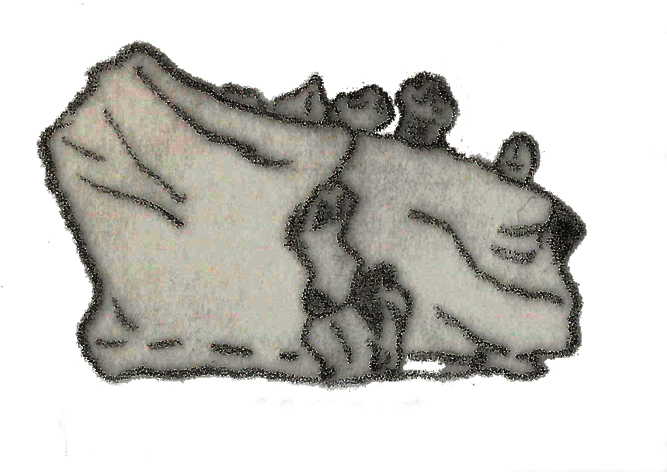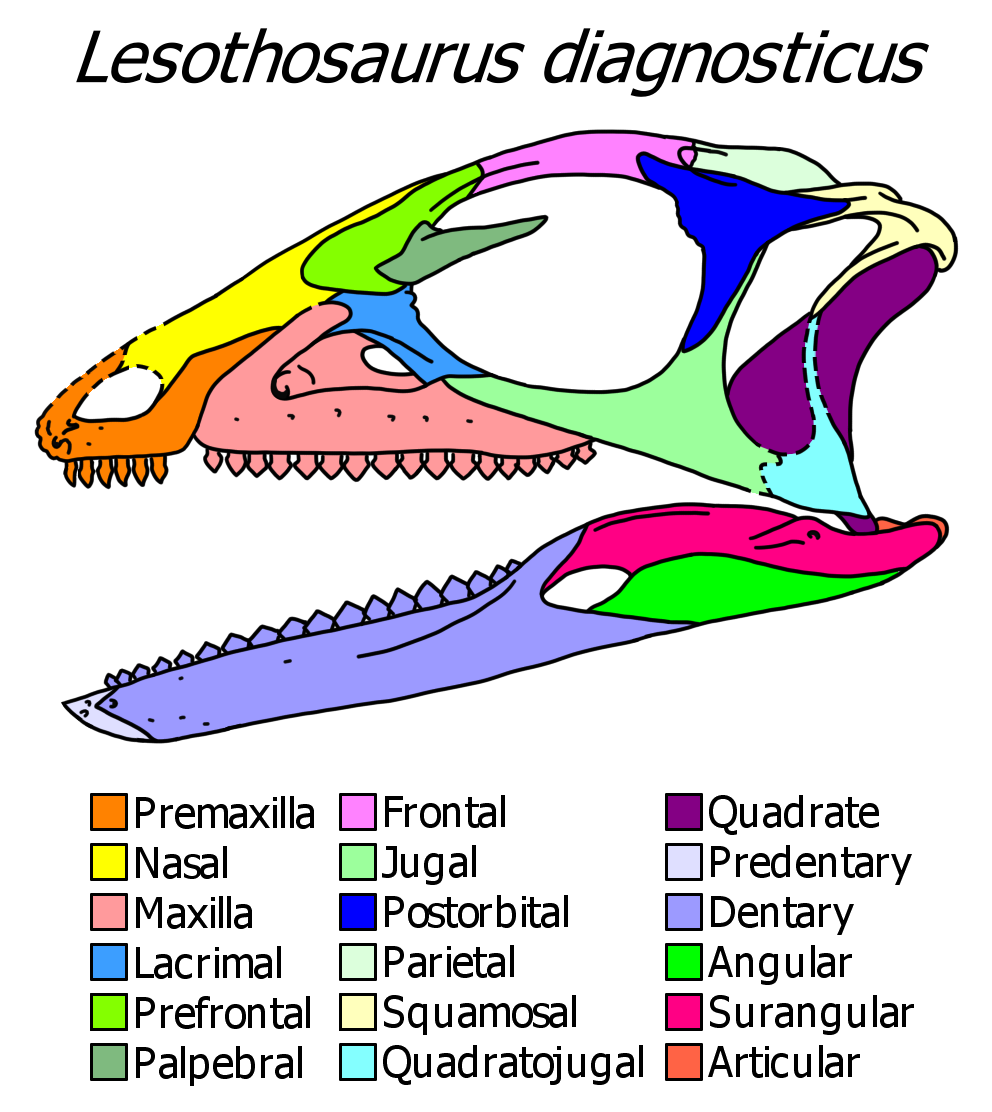|
Lesothosaurus
''Lesothosaurus'' is a Monotypic taxon, monospecific genus of ornithischian dinosaur that lived during the Early Jurassic in what is now South Africa and Lesotho. It was named by paleontologist Peter Galton in 1978, the name meaning "lizard from Lesotho". The genus has only one valid species, ''Lesothosaurus diagnosticus''. ''Lesothosaurus'' is one of the most completely-known early ornithischians, based on numerous skull and postcranial fossils from the Upper Elliot Formation. It had a simpler tooth and jaw anatomy than later ornithischians, and may have been omnivorous in some parts of the year. Discovery and naming Fossils referrable to ''Lesothosaurus'' may have been known from as early as 1959, when a right Mandible, dentary (lower jawbone) fragment bearing three teeth was collected by French geologist Jean Fabre from the Red beds, Red Beds of the Elliot Formation, Upper Elliot Formation near Mapheteng in Lesotho, Southern Africa, dating to the Early Jurassic (199(?)-190 mi ... [...More Info...] [...Related Items...] OR: [Wikipedia] [Google] [Baidu] |
Ornithischia
Ornithischia () is an extinct clade of mainly herbivorous dinosaurs characterized by a pelvic structure superficially similar to that of birds. The name ''Ornithischia'', or "bird-hipped", reflects this similarity and is derived from the Greek stem ' (), meaning "bird", and ' (), meaning "hip". However, as theropod dinosaurs, birds are only distantly related to this group. Ornithischians with well known anatomical adaptations include the ceratopsians or "horn-faced" dinosaurs (e.g. ''Triceratops''), the pachycephalosaurs or "thick-headed" dinosaurs, the armored dinosaurs ( Thyreophora) such as stegosaurs and ankylosaurs, and the ornithopods. There is strong evidence that certain groups of ornithischians lived in herds, often segregated by age group, with juveniles forming their own flocks separate from adults. Some were at least partially covered in filamentous (hair- or feather- like) pelts, and there is much debate over whether these filaments found in specimens of '' Ti ... [...More Info...] [...Related Items...] OR: [Wikipedia] [Google] [Baidu] |
Fabrosaurus Australis
''Fabrosaurus'' ( ) is a dubious extinct genus of ornithischian dinosaur that lived during the Early Jurassic during the Hettangian to Sinemurian stages 199 - 189 mya. ''Fabrosaurus'' was named and described by paleontologist Leonard Ginsburg in 1964 based on the holotype specimen, MNHN LES9, a partial jawbone with three teeth. The name ''Fabrosaurus'' means "Fabre's lizard", honoring Jean Fabre, a French geologist and a colleague of Ginsburg on the expedition that collected the fossil in Basutoland (now Lesotho). The type species, ''F. australis'', was named for the location of the fossil in the Elliot Formation, Lesotho, Southern Africa. ''Fabrosaurus'' was initially placed within Scelidosauridae by Ginsburg, but later studies have placed it as a basal ornithischian. Subsequent discoveries included two crushed skulls and disarticulated post-cranial bones (including vertebrae, ribs, and limb bones), allowing for a more complete reconstruction. However, as additional ornithis ... [...More Info...] [...Related Items...] OR: [Wikipedia] [Google] [Baidu] |
Upper Elliot Formation
The Elliot Formation is a geological formation and forms part of the Stormberg Group, the uppermost geological group that comprises the greater Karoo Supergroup. Outcrops of the Elliot Formation have been found in the northern Eastern Cape, southern Free State, and in the eastern KwaZulu-Natal provinces of South Africa. Outcrops and exposures are also found in several localities in Lesotho such as Qacha's Neck, Hill Top, Quthing, and near the capital, Maseru. The Elliot Formation is further divided into the lower (LEF) and upper (UEF) Elliot formations to differentiate significant sedimentological differences between these layers. The LEF is dominantly Late Triassic (Norian-Hettangian) in age while the UEF is mainly Early Jurassic (Sinemurian-Pliensbachian) and is tentatively regarded to preserve a continental record of the Triassic-Jurassic boundary in southern Africa. This geological formation is named after the town of Elliot in the Eastern Cape, and its stratotype localit ... [...More Info...] [...Related Items...] OR: [Wikipedia] [Google] [Baidu] |
1978 In Paleontology
Paleontology, palaeontology or palæontology (from Greek: ''paleo'', "ancient"; ''ontos'', "being"; and ''logos'', "knowledge") is the study of prehistoric life forms on Earth through the examination of plant and animal fossils. This includes the study of body fossils, tracks ( ichnites), burrows, cast-off parts, fossilised faeces (coprolites), palynomorphs and chemical residues. Because mankind has encountered fossils for millennia, paleontology has a long history both before and after becoming formalized as a science. This article records significant discoveries and events related to paleontology that occurred in the year 1978. Expeditions, field work, and fossil discoveries * A paleoanthropological team led by Mary Leakey found 3.5 million year old human footprints. * Baby hadrosaurs were discovered in the Two Medicine Formation. Cnidarians Maurits Lindström, described the earliest known octocoral in Sweden shifting the first known appearance from the Cretaceous to the Ord ... [...More Info...] [...Related Items...] OR: [Wikipedia] [Google] [Baidu] |
Elliot Formation
The Elliot Formation is a geological formation and forms part of the Stormberg Group, the uppermost geological group that comprises the greater Karoo Supergroup. Outcrops of the Elliot Formation have been found in the northern Eastern Cape, southern Free State, and in the eastern KwaZulu-Natal provinces of South Africa. Outcrops and exposures are also found in several localities in Lesotho such as Qacha's Neck, Hill Top, Quthing, and near the capital, Maseru. The Elliot Formation is further divided into the lower (LEF) and upper (UEF) Elliot formations to differentiate significant sedimentological differences between these layers. The LEF is dominantly Late Triassic (Norian-Hettangian) in age while the UEF is mainly Early Jurassic (Sinemurian- Pliensbachian) and is tentatively regarded to preserve a continental record of the Triassic-Jurassic boundary in southern Africa. This geological formation is named after the town of Elliot in the Eastern Cape, and its stratotype l ... [...More Info...] [...Related Items...] OR: [Wikipedia] [Google] [Baidu] |
Scelidosauridae
''Scelidosaurus'' (; with the intended meaning of "limb lizard", from Greek / meaning 'rib of beef' and ''sauros''/ meaning 'lizard')Liddell & Scott (1980). Greek-English Lexicon, Abridged Edition. Oxford University Press, Oxford, UK. is a genus of herbivorous armoured ornithischian dinosaur from the Jurassic of England. ''Scelidosaurus'' lived during the Early Jurassic Period, during the Sinemurian to Pliensbachian stages around 191 million years ago, at the time when Europe formed an island archipelago. Its fossils have been found in the Charmouth Mudstone Formation near Charmouth in Dorset, England, and these fossils are known for their excellent preservation. ''Scelidosaurus'' has been claimed as one of the earliest complete dinosaur,Norman, David (2001). "''Scelidosaurus'', the earliest complete dinosaur" in ''The Armored Dinosaurs'', pp 3-24. Bloomington: Indiana University Press. . and is among the most completely known dinosaur of the British Isles. Despite th ... [...More Info...] [...Related Items...] OR: [Wikipedia] [Google] [Baidu] |
Heterodontosaurus
''Heterodontosaurus'' is a genus of heterodontosaurid dinosaur that lived during the Early Jurassic, 200–190 million years ago. Its only known member species, ''Heterodontosaurus tucki'', was named in 1962 based on a skull discovered in South Africa. The genus name means "different toothed lizard", in reference to its unusual, heterodont dentition; the specific name honours G. C. Tuck, who supported the discoverers. Further specimens have since been found, including an almost complete skeleton in 1966. Though it was a small dinosaur, ''Heterodontosaurus'' was one of the largest members of its family, reaching between and possibly in length, and weighing between . The skull was elongated, narrow, and triangular when viewed from the side. The front of the jaws were covered in a horny beak. It had three types of teeth; in the upper jaw, small, incisor-like teeth were followed by long, canine-like tusks. A gap divided the tusks from the chisel-like cheek-teeth. The body was s ... [...More Info...] [...Related Items...] OR: [Wikipedia] [Google] [Baidu] |
Nomen Dubium
In binomial nomenclature, a ''nomen dubium'' (Latin for "doubtful name", plural ''nomina dubia'') is a scientific name that is of unknown or doubtful application. Zoology In case of a ''nomen dubium,'' it may be impossible to determine whether a specimen belongs to that group or not. This may happen if the original type series (i. e. holotype, isotype, syntype or paratype) is lost or destroyed. The zoological and botanical codes allow for a new type specimen, or neotype, to be chosen in this case. A name may also be considered a ''nomen dubium'' if its name-bearing type is fragmentary or lacking important diagnostic features (this is often the case for species known only as fossils). To preserve stability of names, the ''International Code of Zoological Nomenclature'' allows a new type specimen, or neotype, to be chosen for a ''nomen dubium'' in this case. 75.5. Replacement of unidentifiable name-bearing type by a neotype. When an author considers that the taxonomic identity ... [...More Info...] [...Related Items...] OR: [Wikipedia] [Google] [Baidu] |
Natural History Museum, London
The Natural History Museum in London is a museum that exhibits a vast range of specimens from various segments of natural history. It is one of three major museums on Exhibition Road in South Kensington, the others being the Science Museum (London), Science Museum and the Victoria and Albert Museum. The Natural History Museum's main frontage, however, is on Cromwell Road. The museum is home to life and earth science specimens comprising some 80 million items within five main collections: botany, entomology, mineralogy, palaeontology and zoology. The museum is a centre of research specialising in Taxonomy (biology), taxonomy, identification and conservation. Given the age of the institution, many of the collections have great historical as well as scientific value, such as specimens collected by Charles Darwin. The museum is particularly famous for its exhibition of dinosaur skeletons and ornate architecture—sometimes dubbed a ''cathedral of nature''—both exemplified by the ... [...More Info...] [...Related Items...] OR: [Wikipedia] [Google] [Baidu] |





